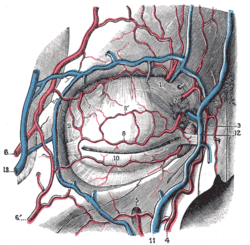Lacrimal artery
| Lacrimal artery | |
|---|---|
 The ophthalmic artery and its branches. (Lacrimal artery visible at center right.) | |
 The tarsi and their ligaments. Right eye; front view. (Lacrimal artery visible at upper left.) | |
| Details | |
| Source | Ophthalmic artery |
| Branches |
Lateral palpebral arteries zygomatic branches recurrent branch |
| Supplies | Lacrimal gland, eyelids, conjunctiva |
| Identifiers | |
| Latin | Arteria lacrimalis |
| TA | A12.2.06.027 |
| FMA | 49927 |
The lacrimal artery arises close to the optic foramen, and is one of the largest branches derived from the ophthalmic artery. Not infrequently it is given off before the artery enters the orbit.
It accompanies the lacrimal nerve along the upper border of the lateral rectus and supplies the lacrimal gland.
Branches
Its terminal branches, escaping from the gland, are distributed to the eyelids and conjunctiva: of those supplying the eyelids, two are of considerable size and are named the lateral palpebral arteries; they run medially in the upper and lower lids respectively and anastomose with the medial palpebral arteries, forming an arterial circle in this situation.
The lacrimal artery also give off one or two zygomatic branches, one of which passes through the zygomatico-temporal foramen, to reach the temporal fossa, and anastomoses with the deep temporal arteries; another appears on the cheek through the zygomatico-facial foramen, and anastomoses with the transverse facial.
A recurrent branch passes backward through the lateral part of the superior orbital fissure to the dura mater, and anastomoses with a branch of the middle meningeal artery.
Variations
The lacrimal artery is sometimes derived from one of the anterior branches of the middle meningeal artery.
Additional images
 Bloodvessels of the eyelids, front view.
Bloodvessels of the eyelids, front view.
References
This article incorporates text in the public domain from the 20th edition of Gray's Anatomy (1918)